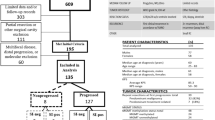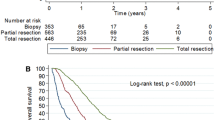Abstract
Objective
Glioblastoma multiforme (GBM) is a nearly uniformly fatal brain tumor with a median recurrence rate of 7 months and survival of 14 months after multimodality treatment. We sought to evaluate outcomes based on the presence or absence of symptoms at the time of recurrence.
Methods
We reviewed 60 patients with GBM treated from 2007 to 2014. All patients had documented radiographic evidence of recurrence. Symptomatic recurrence was defined as development of new or recurring symptoms prior to evidence of radiographic recurrence; those in this group had follow-up imaging confirming recurrence. Asymptomatic recurrence was defined as unequivocal evidence of recurrence on MRI.
Results
Median age for the symptomatic and asymptomatic groups was 58 and 57 years, respectively. Recursive partitioning analysis classes and other clinical factors were similar between both groups. The median time to recurrence was 9.5 months (range 3–49 months). Forty relapses (66.7 %) were symptomatic; 20 (33.3 %) were asymptomatic. Median overall survival (OS) for the symptomatic and asymptomatic cohorts was 17 and 23 months, respectively, a relative difference of 6 months (p = 0.08). Post-relapse survival was 3 months in patients who recurred symptomatically and 10 months for those who recurred by imaging (p = 0.06). Among the asymptomatic recurrence cohort, those who later went on to develop symptoms also had a median survival from symptom onset of 3 months.
Conclusions
In summary, OS is worse in GBM patients who present with symptoms at time of recurrence. This difference in survival is relatively large and should be validated in larger patient cohorts.


Similar content being viewed by others
References
Stupp R, Hegi ME, Mason WP et al (2009) Effects of radiotherapy with concomitant and adjuvant temozolomide versus radiotherapy alone on survival in glioblastoma in a randomised phase III study: 5-year analysis of the EORTC-NCIC trial. Lancet Oncol 10:459–466
Vredenburgh JJ, Desjardins A, Herndon JE 2nd et al (2007) Bevacizumab plus irinotecan in recurrent glioblastoma multiforme. J Clin Oncol 25:4722–4729
Gorlia T, Stupp R, Brandes AA et al (2012) New prognostic factors and calculators for outcome prediction in patients with recurrent glioblastoma: a pooled analysis of EORTC Brain Tumour Group phase I and II clinical trials. Eur J Cancer 48:1176–1184
Stupp R, Wong ET, Kanner AA et al (2012) NovoTTF-100A versus physician’s choice chemotherapy in recurrent glioblastoma: a randomised phase III trial of a novel treatment modality. Eur J Cancer 48:2192–2202
Ghiaseddin A, Peters KB (2015) Use of bevacizumab in recurrent glioblastoma. CNS Oncol 4:157–169
Gutin PH, Iwamoto FM, Beal K et al (2009) Safety and efficacy of bevacizumab with hypofractionated stereotactic irradiation for recurrent malignant gliomas. Int J Radiat Oncol Biol Phys 75:156–163
Hart MG, Garside R, Rogers G et al (2013) Temozolomide for high grade glioma. Cochrane Database Syst Rev 4:Cd007415
Li J, Wang M, Won M et al (2011) Validation and simplification of the radiation therapy oncology group recursive partitioning analysis classification for glioblastoma. Int J Radiat Oncol Biol Phys 81:623–630
Curran WJ Jr, Scott CB, Horton J et al (1993) Recursive partitioning analysis of prognostic factors in three radiation therapy oncology group malignant glioma trials. J Natl Cancer Inst 85:704–710
Scott CB, Scarantino C, Urtasun R et al (1998) Validation and predictive power of radiation therapy oncology group (RTOG) recursive partitioning analysis classes for malignant glioma patients: a report using RTOG 90-06. Int J Radiat Oncol Biol Phys 40:51–55
Park JK, Hodges T, Arko L et al (2010) Scale to predict survival after surgery for recurrent glioblastoma multiforme. J Clin Oncol 28:3838–3843
Muller K, Henke G, Compter I et al (2015) External validation of a prognostic model estimating the survival of patients with recurrent high-grade gliomas after reirradiation. Pract Radiat Oncol 5:e143–e150
Minn AY, Pollock BH, Garzarella L et al (2001) Surveillance neuroimaging to detect relapse in childhood brain tumors: a pediatric oncology group study. J Clin Oncol 19:4135–4140
Bodurka-Bevers D, Morris M, Eifel PJ et al (2000) Posttherapy surveillance of women with cervical cancer: an outcomes analysis. Gynecol Oncol 78:187–193
Bennett JJ, Gonen M, D’Angelica M et al (2005) Is detection of asymptomatic recurrence after curative resection associated with improved survival in patients with gastric cancer? J Am Coll Surg 201:503–510
Ney DE, Carlson JA, Damek DM et al (2015) Phase II trial of hypofractionated intensity-modulated radiation therapy combined with temozolomide and bevacizumab for patients with newly diagnosed glioblastoma. J Neurooncol 122:135–143
da Cruz LC H Jr, Rodriguez I, Domingues RC et al (2011) Pseudoprogression and pseudoresponse: imaging challenges in the assessment of posttreatment glioma. AJNR Am J Neuroradiol 32:1978–1985
Author information
Authors and Affiliations
Corresponding author
Ethics declarations
Conflict of interest
The authors declare that they have no competing interests.
Statement of ethical standards
This article does not contain any studies on humans or animals performed by any of the authors.
Funding source(s)
No funding support is associated with this study.
Rights and permissions
About this article
Cite this article
Amini, A., Altoos, B., Karam, S.D. et al. Outcomes of symptomatic compared to asymptomatic recurrences in patients with glioblastoma multiforme (GBM). J Radiat Oncol 5, 33–39 (2016). https://doi.org/10.1007/s13566-015-0231-6
Received:
Accepted:
Published:
Issue Date:
DOI: https://doi.org/10.1007/s13566-015-0231-6




